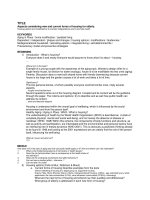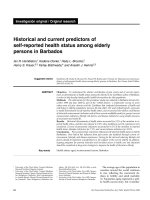Past and Current Agent Trends
Bạn đang xem bản rút gọn của tài liệu. Xem và tải ngay bản đầy đủ của tài liệu tại đây (202.25 KB, 11 trang )
5 Past and Current Agent Trends & Developments
5.1 Introduction
To be able to make predictions about the next step(s) in the development of agents and the
agent technique, several factors have to be considered. In this chapter the past and present of
agents is given a closer look. There are several parties and factors that are related to these, and
they will be looked at in the next sections.
The first factor, which will be looked at rather briefly in section 5.2, is about links between
developments in the area of computers (in general) and agent technology.
Secondly, we will have a closer look at the human factor in agent developments: agent users
(section 5.3) , the suppliers & developers of agents (section 5.4), and the government (section
5.5). In these sections it will be clarified why there is not such a thing as the user or the
supplier, and what benefits governments can get from the agent technology.
Lastly (in section 5.6), past and current developments on and around the Internet will be
subject to a more detailed scrutiny.
Each section will start with the state of affairs and general remarks with regard to that its
subject and will then move on to indicate the links between this factor or party and the agent-
technique.
Most of the information in this chapter, is of a rather general nature, and could just as well
have been put in the next chapter. However, this would have resulted in one, huge chapter,
which does not make it all very comprehensible or readable. Instead of that, it has been chosen
to structure it the way it is now: divided over two chapters, where chapter five built a basis for,
and raises questions about, issues that are discussed in chapter six.
1
5.2 Computers and the agent-technique
The developments on and around the Internet are bearing a strong resemblance to the
development of computers and their interfaces. In the very beginning, computers were hardly
user-friendly, they were commandline-driven and had no form of on-line help whatsoever.
Slowly this changed when the first help functions were added. One of the most important
changes has been the introduction of the Graphical User Interface (GUI), which enabled a
much more abstract view on the operation of a computer. The popularity of computers,
particularly that of home computers or PCs, is largely due to the introduction and further
developments of the GUI.
The Internet developments have followed this pattern in many ways. At first there were not
many people using it, and most of them were highly educated users who were well capable of
working on it without much support or nice interfaces. With the introduction of the Internet's
own "graphical user interface" - the World Wide Web in combination with its graphical
browsers - this changed drastically. From that moment, even novice users are able to use the
various Internet services without having to know how each individual service should be used.
After the introduction of GUIs on computers followed a massive production of all kinds of
applications and programs, most of which exploited GUI capabilities as much as possible. The
same is bound to happen on the Internet too. The major difference between these applications
and the applications that have been written for PCs and the like, is that the former will have to
be more flexible and robust. To put it more boldly: they will have to be more intelligent to be
1 So "Agent Trends & Developments - General remarks" may have been a good name for this chapter as well.
able to function properly in the dynamic and uncertain environment the Internet is known to
be.
Agents are meant to do precisely that.
At this moment, agents are offering this functionality in a very simple form. The chosen form
is usually that of a forms-based interface, or that of a so-called wizard. These latter wizards,
which are basically small background processes, may be considered as simple predecessors of
real agents, as they are very straight-forward (they are usually driven by a set of if-then rules)
and are neither very intelligent nor are they autonomous.
How this is all (expected or predicted) to change, will be described in chapter six.
5.3 The User
At this moment, most users of the agent technique are researchers and a small part of the
WWW user population
2
. But who will be the users of the future, and what will their needs and
demands be? This is an important question, as user-acceptance of agents (leading to user-
demand) is one of the key factors for agent success.
SRI International has conducted a psychographic research into the users of the World Wide
Web
3
. The effort of this research was to augment standard demographics (such as age, income
and gender) with a psychographic analysis of the WWW users
4
. They have used their own
psychographic system (VALS 2) to explore the psychology of people's choices and behaviour
on the WWW.
What makes the results of their research interesting, apart from the unusual (psychological)
approach, is their finding that the Web has two very different audiences:
"The first is the group that drives most of the media coverage and
stereotypes of Web users, the "upstream" audience. Comprising 50% of
the current Web population, this well-documented group are the upscale,
technically oriented academics and professionals that ride on a variety of
institutional subsidies. Yet because this group comprises only 10% of the
US population [...], their behaviours and characteristics are of limited
usefulness in understanding the future Web.
The second Web audience comprises a diverse set of groups that SRI
calls the Web's "other half." Accounting for the other 90% of US society,
these groups are where Internet growth will increasingly need to take
place if the medium is to go mainstream."
Although this research comprises US users only, it still indicates that it would be a bad policy
to talk and predict about the needs, preferences and motivations of the WWW/Internet user, as
there is a broad variety of (types of) users. It is therefore important to find out which of these
groups will be the most dominant and most important ones. This could even mean that groups
2 This group is comprised of mostly experienced, academic users, who like to experiment with and try out
early (test)versions of agents or agent-based applications.
3 See [SRI95].
4 but the findings and conclusions of their research can very well be extended to all Internet users.
of users have to be accounted for in the future, that are not using the WWW and the Internet
right now:
"Many information-intensive consumers in the US population are in the
other-half population rather than the upstream population. These
particular other-half consumers report the highest degree of frustration
with the Web of any population segment. Although they drive much of the
consumer-information industry in other media, they as a group have yet to
find the Web particularly valuable."
The "information have-nots" (a term coined by SRI) are not able to use the Internet and its
services as result of a low income, but because of limited education. Tackling this problem
requires an approach that is completely different from the one that is used at this moment to
ensure that everybody can use the "information highway".
Agent technology can be brought into action here. Not that agents can solve the entire problem
as described, but they can do their bit by making usage of the Internet (and computers as well)
more user-friendly and easier. At this moment a lot of research is done in the area of so-called
interface agents. These are agents whose main purpose is to provide an easy-to-use interface
to complex systems such as the Internet, but also to computers in general. By means of such
things as animated characters, computers and all kinds of other systems are given a more
human appearance. This will make it easier for both novices and experts to operate them.
5.4 The Suppliers & the Developers
As much as there is not such a thing as the user, there also is not such a thing as the developer
or the supplier. Until recently, developers of Internet applications and techniques were mostly
(academic) researchers. With the emergence of the Internet as a commercial market, many
other parties are starting to do research and develop techniques and applications for the
Internet:
"The emergence of the Internet and the World Wide Web has created a
heightened demand for intelligent software agency. From a functional
perspective, utilisation of the Web is moving from a scattered browsing
model to an efficient point-to-point information transfer medium. This trend
has (and is) driving the intelligent agent development from academic
research environments and proprietary corporate uses to mass
commercial usage."
from "Intelligent Agents: a Technology and Business Applications analysis" by Mark Nissen
Moreover, many suppliers of information and/or services play a double role as they are
(becoming) developers as well.
This has its effects on developments in the agent technique. Aspects that were of minor
importance in the past, such as profitability of a technique and whether or not it meets a
certain market or user demand (and how well this demand has been met), are becoming major
issues now. Companies use the Internet and agent-based applications as a means to draw
attention to other products they sell (e.g. like Sun Microsystems who use the JAVA technique
to sell more Internet servers
5
) or as a profitable extension of existing products (e.g. like IBM
who are developing agents to extend their groupware and network software packages).
So, predicting tomorrow's developments depends strongly on who is leading developments
today. A commercial 'leader' will want agents to have quite different characteristics compared
to, say, academic researchers. An overview of these differing aims is given in the following
table:
Commercial developers' aims: Non-commercial developers' aims:
1
.
The aim usually is to move on to the
practical implementation as soon as the
related theory has been sufficiently
worked out (i.e. theoretical research
should be sufficiently elaborated, but
does not need to be exhaustive, at least
not immediately);
Non-commercial developers will (most
probably) first do extensive research into
a complete (and well-defined) concept or
application, before moving on to sub
concepts and the practical implementation
(if they move on to this stage at all);
2
.
Agents should be profitable - somehow -
within a foreseeable period of time;
Agents may turn out to be profitable (or
have potential to be so), but this is not an
explicit aim;
3
.
User/market demand(s) plays a very
important role in the development
process. Because of this importance
however, unforeseen applications or
demands may be overlooked;
Theoretical soundness, robustness and
completeness are most likely to be
important factors in the development
process. User/ market demands usually do
not come into play until the practical
implementation stage is reached (and may
not be always that well known). Research
may also tend to stay in the theoretical
stage too long;
4
.
Commercial developers will probably not
be extremely interested in developing
generally agreed upon, open standards
(unless this standard is the one they have
invented themselves).
The aim (although not always explicitly)
is to come to general/open standards, or at
least reach a consensus on vital issues, as
this makes it easy to work together with
other groups and share results (preventing
duplicate work/research from being
done).
Neither of these two "extremes" is very desirable: agents should not remain "an interesting
research object" until eternity, but neither should research be aimed at merely scoring quick
results.
A lot of attention should be paid to the demands of users (and other parties) in 'the real world'.
However, care should be taken that not only the needs of the largest or the most profitable user
groups are catered for, but also those of smaller groups and even of user communities that
have yet to be discovered.
5 JAVA itself is not an agent-application. Yet, the Java Agent Template is available which "provides basic
agent functionality packaged as a Java application. This agent can be executed as a stand alone application or
as an applet via a WWW browser".
In [JANC95] developers find that the development and support costs of agents are about the
same as with other forms of development. Most developers create applications for a single
domain. Because they control the domain
6
, they can manage the costs of development and
support. In the report, developers predict an increase in cost once agents become mobile,
irrespective of whether one single agent model (i.e. all agents use the same language, such as
Telescript) or several models are used
7
.
6 i.e. they know exactly what domain they will be used in.
7 more about this will follow in section 6.2.









